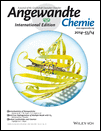Selective Host–Guest Interactions of a Transformable Coordination Capsule/Tube with Fullerenes†
This research was supported by the Japan Society for the Promotion of Science (JSPS) through the “Funding Program for Next-Generation World-Leading Researchers” and by the Japanese Ministry of Education, Culture, Sports, Science and Technology (MEXT) through Grants-in-Aid for Scientific Research on Innovative Areas (“Coordination Programming”). N.K. thanks the JSPS for a Research Fellowship for Young Scientists. We also thank Dr. Yoshihisa Sei (Tokyo Institute of Technology) for supporting X-ray crystallographic analysis.
Graphical Abstract
Varying degrees of hospitality: An M2L4 coordination capsule and an M2L2 coordination tube formed from HgII hinges and bent bispyridine ligands underwent reversible interconversion at room temperature in response to changes in the metal-to-ligand ratio (see picture). Only the capsule accommodated large spherical molecules, fullerenes C60 and C70, and the bound guests were released upon transformation into the tube by the addition of metal ions.
Abstract
An M2L4 coordination capsule or an M2L2 coordination tube was selectively formed by the combination of HgII hinges and bent bispyridine ligands. The two structures reversibly interconvert at room temperature in response to modulation of the metal-to-ligand ratio and exhibit different host–guest interaction behavior. The capsule alone encapsulates large spherical molecules, fullerenes C60 and C70, and the bound guests are released upon capsule-to-tube transformation by the simple addition of metal ions.





